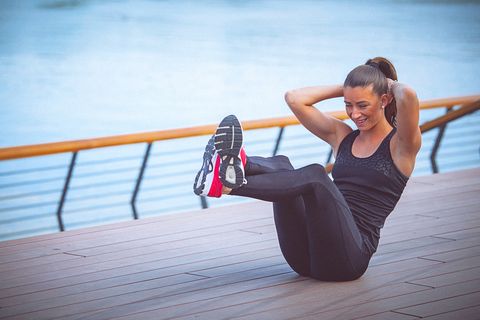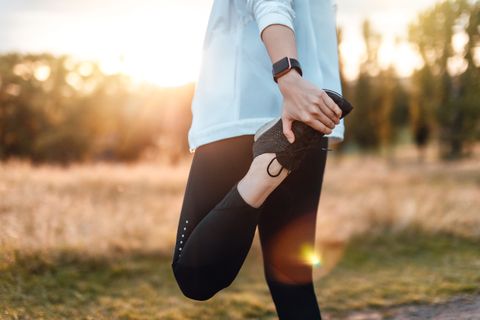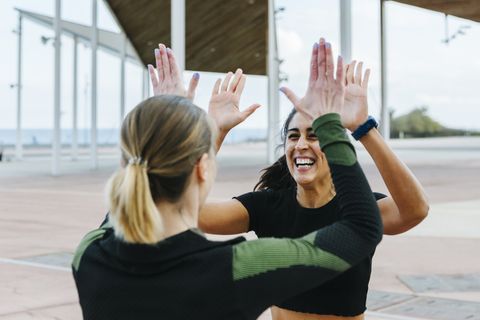
MoMo ProductionsGetty Images
Starting a fitness journey is amazing for both your mind and body, but sticking to it can sometimes prove to be difficult. Too often we set unrealistic fitness goals which are unsustainable in the long run. If you’re looking to up your exercise, setting specific and achievable targets can be the secret to lasting change.
“It is important to set fitness goals as a way to hold ourselves accountable for pouring into ourselves just as much (if not more) as we pour into others,” says Dr. Chelsea Jackson Roberts, Ph.D., Peloton Yoga & Meditation Instructor. “I recommend starting off small and committing to celebrating the small wins.” She adds that setting realistic goals is important as well to not overwhelm you (or your body) and avoid burnout.
Editor’s Note: You should clear any long-term changes to your fitness routine with your primary healthcare provider beforehand. Weight loss, health and body image are complex subjects — before deciding to switch up your exercise and fitness levels, we invite you to gain a broader perspective with our exploration into the hazards of diet culture.
When it comes to staying motivated, it’s important to focus on all of your progress along the way. “I am a big stickler for progress over perfection,” says Kirsten Ferguson, Peloton Tread Instructor. “Enjoy every little, small victory in the process towards greatness.”
Whatever fitness goals you decide to set are unique to you and need to be suited to your lifestyle. Remember to consult your healthcare provider prior to starting any new fitness regimen. Here are some fitness goals examples to get you started on your wellness journey:
1. Start a Walking Program
A smart goal doesn’t need to always be high intensity. A walking program is a great entry into fitness because it’s free and easy to start. Plus, walking regularly can even improve longevity. You may notice significant improvements to your health in just two weeks of a power walking routine, ranging from benefits like decreased blood pressure to stronger leg muscles.
How to achieve it:
- Beginners can start with walking 10 minutes per day for the first two weeks. Aim for a 3 to 3.5 mph pace on the treadmill, or about a 17-20 minute per mile pace outdoors. You can advance your routine by increasing your pace, time or incline.
- Find a scenic walking path if you’re able to that keeps your stroll interesting. Try recruiting a friend or family member to walk with you for extra accountability.
2. Grow Stronger Glutes
Your gluteal muscles assist everything from proper posture to helping you power through workouts, but we often spend more time sitting on our glutes than using them. Training your glutes has a ton of benefits, from helping prevent knee injuries to supporting the lower back. You’ll see improvements in activities like running, jumping and even heavy lifting when you train your glutes since they are essential for creating power and acceleration.
How to achieve it:
- Incorporate glute-toning exercises into your workout regimen at least three days a week to start seeing and feeling results.
- Try using resistance bands to start out; they are great for enhancing the mind-muscle connection and increasing the time in which your muscles are under tension. They naturally can help with form feedback too.
3. Improve Upper Body Strength
Lifting and carrying anything becomes much easier when you have substantial upper body strength. Daily tasks like hauling groceries, picking up kids, even shoveling snow all become easier when you are working with a strong upper body.
How to achieve it:
- Incorporate arm-strengthening exercises into your workout regimen at least three days a week to start seeing and feeling results.
- Try working up towards 20 pushups or strengthening your arms to eventually be able to do one pull-up. Some of the best arm exercises can be done with bodyweight and don’t require any dumbbells.
4. Build a Stronger Core
More than just aesthetics, a strong core is essential for building stability, improving posture and reducing low back pain. What’s more, proper core engagement is necessary for other major exercises like squats and push-ups. Even daily tasks like bending down to put on shoes, lifting a package and standing up all require core strength.
How to achieve it:
- Try to do at least 10 minutes of core focused exercises three times a week to start seeing and feeling results.
- Work up towards holding a minute-long plank, and try to focus on engaging different angles of your abdominal muscles with exercises like side-planks.
5. Boost Your Cardio Endurance
Cardiorespiratory exercise has benefits like strengthening the heart and respiratory muscles, reducing cholesterol levels and arterial blood pressure, increasing lean body mass and even optimizing metabolic rate. You don’t need to spend hours on a treadmill to boost your cardio. High intensity interval training is a great way to get efficient cardio done and can be used in a variety of exercises.
How to achieve it:
- Jogging and running are great entry into building cardiorespiratory fitness. Setting goals like building up to a 5K or 10K can give you something to work towards and look forward to. Set a realistic time frame and map out a running schedule.
- Try a new piece of cardio equipment like the rowing machine or jump rope to change things up and keep your workouts interesting.
6. Lift Weights
While bodyweight workouts can provide tremendous fitness gains, lifting weights is definitely a way to level up your workout routine. Incorporating strength training into your workout regimen can increase lean body mass, help gain bone density and even enhance flexibility and sleep. Plus, lifting weights can help reduce risk of several chronic diseases.
How to achieve it:
- Start with two to three weight training sessions per week. Be sure to listen to your body and start with light weights.
- Form is key, and investing in even just one or two sessions with a qualified fitness professional to teach you technique can be essential. Many fitness apps also have great weight training programs to follow and virtual communities for extra support.
7. Increase Your Flexibility
Flexibility does vary widely from person to person, but inactivity or lack of stretching can all play a role in minimizing the body’s range of motion. Lengthening and stretching muscles can help prevent injuries and energize the body too. Regularly stretching can also give muscles more full range of motion.
How to achieve it:
- Set a goal of stretching first thing in the morning for 10 minutes. Morning stretches can help increase blood flow to muscles and joints, preparing your body for the day ahead. If you’re doing other workouts, aim for a five-minute cooldown stretching session at minimum to properly recover.
- Hold each stretch for at least 30 seconds, which allows the muscle to fully relax. Turn on some soothing music or listen to a podcast to help pass the time by.
8. Learn a New Skill
Maybe you’ve been thinking about taking a boxing class for a while now, or are looking to join a local sports recreational team. Take the plunge and try something new! Learning a new skill can keep things interesting and exciting, encouraging you to keep going with your fitness routine and goals.
How to achieve it:
- It’s a good idea to work with a coach or join a class with an experienced instructor who can teach you proper form and technique of whatever new skill you are learning to do.
- Be patient with yourself, take things slow and enlist a friend to join in on the fun while holding you accountable too.
9. Meditate Regularly
Fitness isn’t always about hitting the gym; working on the mind-body connection is crucial too. Meditation is a great way to increase calmness and physical relaxation. Some studies show that meditating can decrease blood pressure and symptoms of anxiety and depression. There is no right or wrong way to meditate, and committing to even five minutes a day can make a tremendous difference.
How to achieve it:
- Set up a meditation space in your home. This can be as simple as a quiet corner with a comfy chair and a few small plants.
- If you’re not sure where to start, try a meditation app for guidance. Some sessions target specific issues like anxiety, sleep and stress, so you can tailor the meditation experience to what suits you best.
10. Prioritize Recovery Days
“One example that doesn’t get enough celebration is the fitness goal of rest and recovery,” Roberts says. “For every day or hour that you work out, try and commit to that equal amount of rest either the same day or the next.” If you’re starting up a new exercise regimen or performing exercise that you haven’t done in a while, proper recovery is especially important because you may experience delayed onset muscle soreness. We know that exercise has a slew of health benefits, and in order to stay consistent with a workout regimen, proper recovery is essential.
How to achieve it:
- Sleep is your body’s time to repair, recuperate, and recover. Your emotional, mental, and physical health all benefit from adequate sleep. A great place to start is moving up bedtime by about 15 minutes to get more rest.
- Utilizing a myofascial release tool like a foam roller can help relieve muscle tension and soreness while also improving range of motion. By taking the time to foam roll, especially after a tough workout, you can help promote the recovery process.
Tips for Staying Motivated
- Set S.M.A.R.T. goals: “Setting smart fitness goals are so important to keep you focused and accountable,” Ferguson says. Try to make each goal specific, measurable, achievable, realistic and timely. “Far too often, people set fitness goals without a plan, with no time limit and they aren’t realistic to achieve and when they don’t happen right away, unfortunately people quit.” She adds that with every goal you set, it’s important that they are not only realistic but also small and manageable. Focus on setting a timeline and choosing a goal that is meaningful to you.
- Mark time in your calendar for exercise: “Set a schedule just like you set a meeting on your work calendar or your kids after school schedule. Make the times realistic when you know you will have the least amount of distractions,” Ferguson recommends. “Just as we schedule lunch dates and place responsibilities for work in our daily calendars, it is just as important to place those commitments towards our fitness goals there too,” Roberts adds.
- Recruit a workout partner: A friend or family member can help hold you accountable and make working out even more enjoyable. “I think there is something so powerful in knowing that you aren’t going at your goals alone,” Ferguson adds. “On the days that you really don’t feel like doing it, your friend will motivate you to show up and show out!” But if you can’t work out together in person, there are still ways to connect. “Even if you can’t be in the same physical place as the individual, create opportunities to check in or even Facetime during a workout,” Roberts says.
- Get some support: Ferguson says it’s a good idea to let your friends, family, even children know about your goals and how they can support you in achieving them. “We all want to see you win!”
- Journal throughout your fitness journey: “I am a big proponent of reflecting on my experiences through journal writing,” Roberts shares. “Practice recording your workouts either written or even voice memos. For me, this is a practice that helps me see and hear my accomplishments over time.”
- Find some great fitness goals quotes: An inspirational quote can be an amazing motivator. Write it out and place it somewhere visible, or make it your phone background or desktop image so you see it every day.
This content is created and maintained by a third party, and imported onto this page to help users provide their email addresses. You may be able to find more information about this and similar content at piano.io









No comments:
Post a Comment